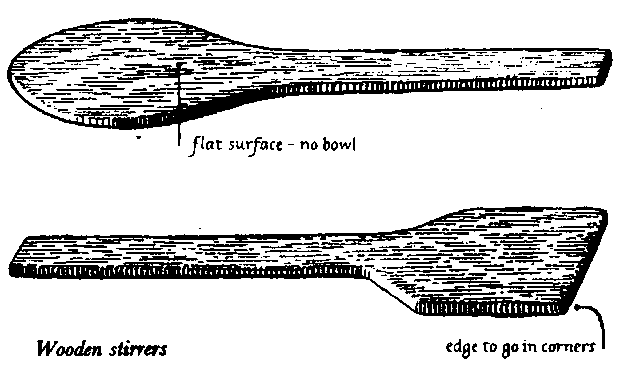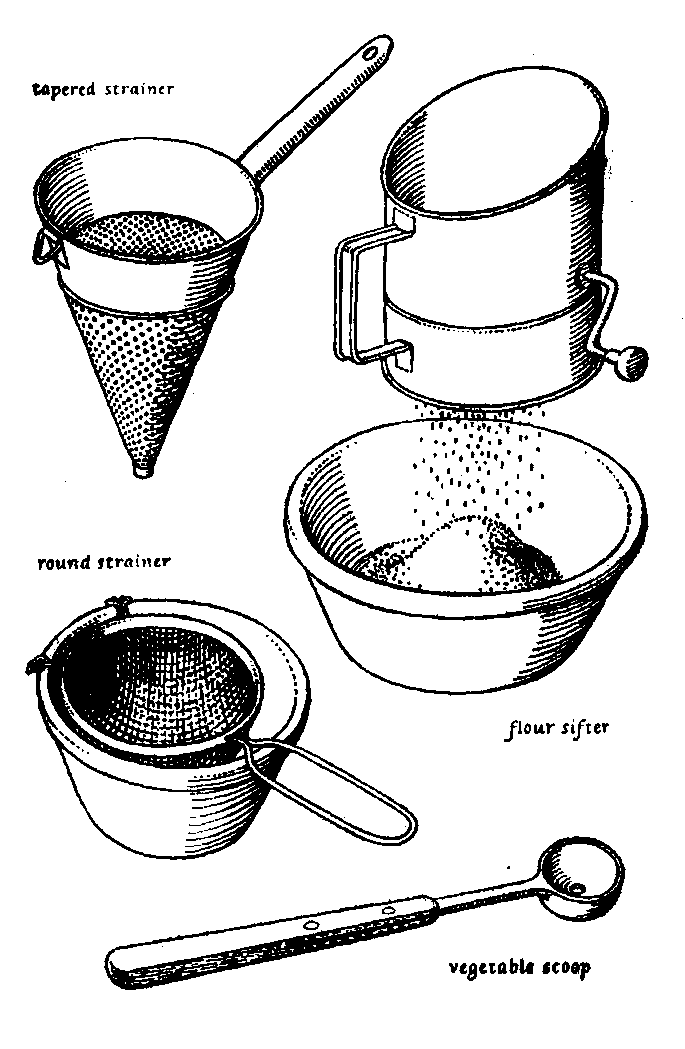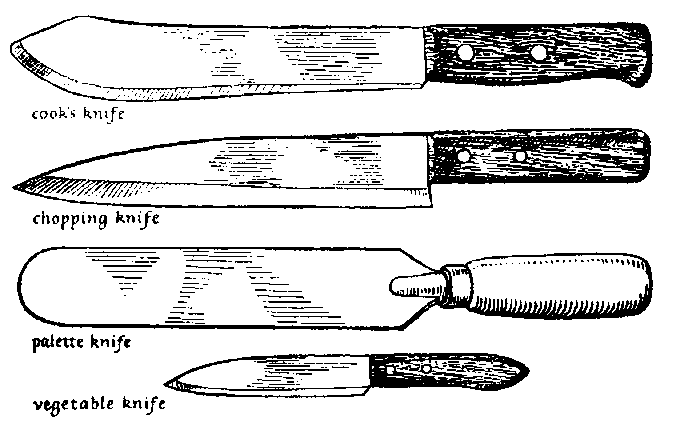
Chapter 4 assembles 20jy02; all here 21jy02
18-27 pp27-33
|
2 saucepans, 1.5 pt [855ml] |
1 casserole with lid, 3 pt [1710ml] |
|
1 saucepan, 3 pints [1710ml] |
1 pudding-basin, 4" [100mm], .5 pt [285ml] |
|
1 saucepan 8 pints [4.545l] |
1 double boiler, 3 pint [1710ml] |
|
1 steamer |
1 pudding-basin, 6" [150mm], 1.5 pints [850ml] |
|
1 frying-pan, 8-9" [200-225mm] |
1 pudding-basin, 7.5" [190mm], 3 pt [1710ml] |
|
1 omelette pan, 6-7" [150-175mm] |
1 kettle 3 pints [1710ml] |
|
1 cake tin 6-7" [150-175mm] |
1 mixing bowl 10-12" [250-300mm] |
|
1 cake-tin 8-9" [200-225mm] |
4-6 individual pudding moulds |
|
2 sandwich tins, 7-8" [175-200mm] |
1 pair kitchen scales or 1 or 2 measuring cups |
|
1 flan-ring, 7-8" [175-200mm] |
1 set bun-tins |
|
1 round strainer, 6.5" [165mm] |
1 oblong cake-tin, 9 x 6" [225x150mm] |
|
1 roasting-pan, 2" [50mm] smaller than oven |
1 tapered strainer, 5" [125mm] |
|
1 colander |
2 baking-trays, 2" [50mm] smaller than oven |
|
1 flour-sifter |
1 flour-dredger |
|
1 ring or border mould |
1 biscuit-forcer |
|
1 metal jelly-mould, 1.5 pt [850ml] |
1 icing-forcer' or set of tubes and bag |
|
1 enamel or fireproof plate 8" [200mm] |
1 mincer |
|
1 pie-funnel |
2 Pie-dishes, 1.5-2 pints [850-1135ml] |
|
1 vegetable brush |
1 casserole with lid, 1.5 pt [850ml] |
|
1 saucepan brush |
Steel wool |
|
Sugar or fat thermometer |
1 knife-sharpener |
|
1 frying basket, smaller than pan |
1 pair kitchen scissors |
|
Oven thermometer or automatic control on cooker |
1 round wire egg-whisk, 7-8" [175-200mm] |
|
1 rotary egg-whisk, large |
1 can opener |
|
Storage bins |
1 corkscrew |
|
1 refuse bin, with lid |
1 set metal skewers |
|
Measuring spoons, I or 2 sets |
1 grater, general purpose |
|
Salt and pepper shakers |
2 wooden spoons, 10" [250mm] |
|
1 lemon-squeezer |
1 wooden stirrer, 10" [250mm] |
|
1 coffee grinder |
1 basting spoon |
|
1 coffee-brewer |
1 ladle |
|
1 rolling pin, 12" [300mm] |
1 perforated spoon |
|
1 pastry-board, 20 X 12" [600x300mm] |
1 fish slice |
|
1 chopping-board, 8 x 6" [200xq50mm] |
1 cook's knife |
|
1 potato-masher |
1 vegetable knife, 3-4" [75-100mm] |
|
1 Wire cake-cooler |
1 potato peeler |
|
1 pastry brush |
1 grapefruit knife |
|
1 set biscuit cutters, fluted |
1 apple corer |
|
1 set biscuit cutters, plain |
1 palette knife, 8" [200mm] |
|
Butter muslin |
|
[g p28]

[g p29 all]

|
Kitchen cloths |
1 Sink tidy |
|
Oven cloths |
1 vegetable scoop to cut vegetable balls |
|
Swabs |
|
Having the right utensil of good quality can make the difference between success or failure, and it most certainly does make a great difference to the amount of time and labour involved. Other craftsmen who handle tools such as carpenters, builders, engineers, etc. - all know it is difficult to obtain good results with shoddy and inadequate equipment. It is just the same with cooking. When buying new equipment it is therefore, important to know how to choose wisely, and I hope the following tips will help the inexperienced.
No matter what kind of stove you use it is important to have good, thick pans. Thin pans buckle with the heat, make food stick and burn, and are an endless source of worry and hard work. Aluminium or stainless steel are the most hard wearing. If enamel Pans are preferred, they should be very good quality, as poor enamel soon chips. Good pans have well fitting lids and insulated handles so that they do not become too hot. They should also be smooth in all joints, without crevices and dents, which are hard to keep clean.
It is even more important that these should be thick and heavy. Thin frying pans soon buckle, and food burns in one spot and does not cook in another.
Scales & measures. See No. 1-6.
Good, sharp knives save endless time, so it is advisable to buy the best you can find and keep them sharp. Cooking with ordinary table knives is very difficult, as well as being hard on the knives. A potato peeler is useful for many vegetables and once you have the knack of using it, it is much faster and better than an ordinary vegetable knife.
[g p31]

Again, good, thick pans are essential, as thin ones buckle, making cakes and pastry rise and brown unevenly. The best baking trays are those with an edge all round, as this prevents any spilt liquid from falling into the oven. Food cooked in new, shiny pans does not brown very well, and it is a good plan to bake new tins (not aluminium) in a hot oven for a little while before using, to dull the surface.
These can be of heat-resisting glass or china, enamel, aluminium or steel. The most useful casseroles are those which can be used on top of the stove as well as in the oven, and which are sufficiently attractive to be sent to the table. The lids should fit well. Sometimes the lids are suitable for using alone as baking-dishes for fish, tomatoes & other similar foods.
These should have a sharp edge, especially where the metal joins. Many joins are so clumsy that it is impossible to make a clean cut.
1 Always wash and rinse well, as dirty utensils spoil the flavour of food cooked in them. To make cleaning easy, Put all utensils to soak as soon as they are finished with. Those used for flour mixtures, fish, egg, and milk should be soaked in cold water, as hot tends to make the food stick.
2 IF food sticks or burns, soak the dishes well before attempting to clean them. Then use fine steel wool or a nylon pot scraper.
3 Never pour cold liquid into a very hot pan or dish. Either cool the pan or heat the liquid.
4 To obtain a smooth surface on frying-pans, for omelettes and pancakes, rub the dry Pan with cooking salt and a piece of paper.
Aluminium: Do not use soda or strong washing powders, as these tend to pit the surface, as does failure to dry the pans Properly. Fine steel wool is the beat thing to use for cleaning aluminium.
Glass, earthenware & china: If food sticks, soak until it can be removed easily and avoid scratching by scouring. Do not plunge a hot dish into cold water.
Enamel: Avoid scouring, as this scratches the enamel. If the pan has burnt, boil salt water in it several times until the burn has softened enough to removed without scratching. Once the surface has been scratched, foods burn more readily. Do not use chipped enamel utensils, as small bits are likely to come off into the food. An empty pan should never be put on a hot stove, or the enamel will chip.
Steel: Avoid scratching with scourers and always dry well.
Tin. Avoid harsh scouring which scratches the tin & always dry well to prevent rust. Dry with a cloth and then stand in a warm place.
Wood: Scour well and dry thoroughly. Fine steel wool is good for cleaning wood.
In the last few years many people have become enthusiastic users of pressure cookers and saucepans. These are time- and fuel-savers, and can be a great help to the busy housewife. There are may different types, sold with detailed instructions for use. These should be followed carefully.
Though many people use pressure cookers for cooking vegetables; the greatest saving in time is made with dishes which usually take .75 hour or longer to cook, for example, making soups and stock, boiling beetroot, stewing, braising, boiling meat, and cooking dried peas, beans, and lentils.
In a number of such recipes I have indicated the times I use for pressure cooking. These are intended as a guide only, and may need adjusting with different cookers. As a general rule the time required in a pressure cooker is a quarter to a third of that needed for boiling in a saucepan.